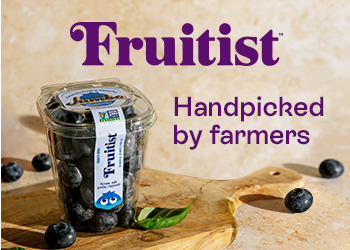Blueberry production could rise 50% by 2018, but will that be enough?

The North American Blueberry Council's (NABC) latest World Blueberry Acreage and Production Report has been released following extensive questionnaires and interviews around the globe. It reveals production surpassed one billion pounds in 2012, which is set to grow by 500 million pounds in the next half-decade. Report author Cort Brazelton received "comment after comment" about the need for wider market penetration through food service and new market access. He also told www.freshfruitportal.com how mainland Europe and China were catching on to the fruit's potential. 
A growth rate of 50% can carry concerns of depressed prices for any product, but in the case of blueberries a sense of perspective is needed - the NABC's 2018 global forecast is still smaller than California's fresh strawberry crop.
"Almost 80% of global volume is consumed in North America, but that's only 400 million people - most of it's in the U.S. and Canada - but what about the other 6.6 billion people in the world, of which half can afford to eat blueberries and want blueberries? Where's their fruit going to come from?" Brazelton said.
"Most of the volume over the next five years is going to come primarily from the United States, Chile, Canada, Europe and China."
A telling fact for Brazelton is that three of these key production zones are far from being mature markets for the fruit, and each one is showing signs that will become emblematic for the industry over the course of the next decade.
Non-western consumption
Albeit in a small way, Chile represents an adage given to Brazelton by an Egyptian blueberry grower four years ago, that "the west does not have a monopoly on the desire to eat healthy".
"Go to any major Chilean grower-exporter, or even Argentineans, and ask how much fruit went to Brazil compared to five years ago. Back then it was close to zero, but this last year they did business there and it was worth doing," Brazelton said.
"And for five months of the year in Santiago you can walk into the supermarket and buy them - for a long time it was just Hortifrut but now there are copycats putting blueberries in the Chilean supermarkets.
"Latin America will be a market. A large minority of South America's fruit may be consumed in Latin America in 15 years from now, and a big portion of it may be exported to China or Indonesia for example, just as much as it ships it to Europe or North America.
Brazelton added that South Korea, although a comparatively small market next to China, could become the "next Japan" in terms of demand growth.
He said the trend of local consumption in blueberry-producing countries could be seen around the world and would have a bigger role to play in the future, whether it be in the Middle East, southern Africa or central Europe.
"For example, Poland still has lower purchasing power on average compared to its neighbor Germany, but a larger portion than ever of the highbush Polish crop is being consumed by their own growing middle class," he said.
Germany in the game
This brings Europe into the picture. The U.K. is the world's second-largest blueberry market but still only has a penetration level of 35%, compared to the U.S.' 51% level.
Brazelton was excited by the fact that during a period of declining produce consumption on the old continent, berry consumption has actually risen.
"If mainland Europe continues to follow these trends in consumption we’re seeing now, it’s going to be very big, but I’m worried about where the fruit will come from. On the one hand we have these big volumes in fruit in some areas, it’s hard to pack and figure out how to sell it all, and in parallel we have limited clarity about whether volume demand will be met.
"The message at Fruit Logistica that I heard loud and clear was that mainland Europe is starting to eat blueberries, especially German-speaking Europe, Scandinavia, Russia and Italy to a lesser degree too," he said.
"Retailers have discovered blueberries as a profit center. When you have blueberries, not just blueberries but all berries in the store every day, people buy them, they don’t take up too much space, and they make you money; something the U.S. retailers keyed in on years ago.
He added that German consumers were moving away from considering blueberries as seasonal with many now consuming Spanish blueberries in the spring.
Once again, Europe's demand relevance to future blueberry supplies is underscored by the perspective of relative acreage.
"Europe has the acreage of British Columbia, has roughly the production of the state of Oregon, but has 750 million people," Brazelton said.
China's growth
Brazelton says China has a comparable acreage to Europe, taking the mid-point of a wide range of estimates, while it has the potential to become the world's largest blueberry market in the next decade.
"I believe that the 2005 acreage figure that I have for China is pretty accurate, probably somewhere around 1,000-1500 acres. The problem with China's figure today is that it's acreage is somewhere between 15,000 and 35,000 acres," he said.
"It's crazy. It's so hard to make any sense of that because there are a lot of challenges in getting good data from China - there are concerns about tendencies to report not only the existing acres as real, but a tendency to report future plans as today’s reality, or even future intentions as today’s reality.
"Additionally, because most of the good land and water in China is designated for strategically important food crops for food security, much of the land being planted for blueberries in China is not the best blueberry ground."
He said China had multiple growing regions such as the far northeast, the coastal south and the inland south, but the northern coast was the most likely to be called the "flagship" blueberry area at the moment.
"Most of the acreage today that’s semi-competitive in China is in the Shandong province and to a lesser extent in Liaoning," he said.
"There is a lot of planting on ground that is not ideal for blueberries because that is what’s available, and China is still discovering the best places to grow blueberries.
"It wouldn't shock me if the leading growing regions of the future are not the same as the leading growing regions of today."
He added that summer monsoons posed problems for China's supply in the future.
"It's not uncommon in July or August to have a really challenging event, which makes it really difficult because that’s when they’d be in peak harvest in the open field.
"That's one of the benefits of growing in Chile, western North America and western Europe. It’s one of the reasons why I believe potentially Peru, Mexico and especially Chile and the west of North America are situated not only to supply the Americas, but effectively to supply the Pacific.
"When it’s raining like a banshee in July in Shandong, we have beautiful quality in Oregon and Washington."
The U.S. does not yet have Chinese market access but Chile does. Brazelton emphasized the importance counterseasonal supply will play in that market.
"China’s has a huge need for counter seasonal supply and the opportunity that affords Chile if the Chilean industry can successfully deliver quality blues after the long boat ride."
Overcoming the challenges
While the industry is excited for its prospects, Brazelton said the bad news was the correction periods in store.
"Chile’s had a slowdown that’s going to continue to have some challenges, and we have some challenges coming on the West Coast of North America that we’re only moderately aware of - volumes, labor costs, the availability of land and water, and pests too.
"We will go through some bumps on this road over the next 10 years. An increase from one billion to 1.5 billion pounds over the next five years is a big growth increase.
"We need to find ways to manage these volumes, to keep prices healthy, deliver value to consumers, positive eating experiences, and we have to always seek to innovate as an industry to be better than we have been before."
To raise market penetration further, Brazelton said blueberry quality needed to improve, and to increase the number of frequent users.
"And we need to enter the channels that blueberries haven’t entered, specifically food service, and new differentiated processed products.
"When the industry successfully delivers shelf stable blueberry products to the market, markets like India are going to take off like crazy."
Do you want access to the full report? To do so, you will need to become a member of the North American Blueberry Council (NABC) or the International Blueberry Organization (IBO).












































